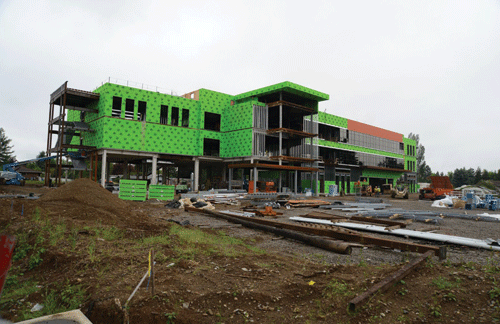
A state-of-the-art facility
This 69,000-square-foot magnet high school will give students hands-on experience for careers in biosciences and healthcare; the school’s 26 classrooms will eventually accommodate a total of 500 students. Local general contractor Skanska USA broke ground on the project in October 2011, and project manager Cory Zonich, said the project could be completed perhaps as early as December of this year.
Current activities, said Zonich, include installing the exterior skin, finishing the glass wall and brick masonry and installing the roof. He said one of the biggest challenges is that the building, designed by local architect firm LSW Architects, is “not a rectangle.”
“The glass and brick start and stop often,” added Zonich. “It’s fun to coordinate.”
“It’s really exciting,” said Sue Steinbrenner, director of facilities for Evergreen School District. “I like the openness of the design, with lots of glass, and Skanska has been fabulous to work with.”
Other construction challenges are associated with the nature of the school’s curriculum, which demands significant lab space. Zonich said routing all the utilities to the lab benches and installing vacuum hoods and piping for waste chemicals was like putting together a puzzle so that “it all works and looks great.”
The school also features fully-operational nursing stations. Zonich said building HeLa High has been “like building a small hospital.”
One unique feature of the school is that it uses exposed concrete floors.
“We’ve spent a lot of energy ensuring that they are going to look great,” said Zonich. “I can’t wait to see it when it is finished.”
The cement floors will feature in-floor heat, which Steinbrenner said will help with keeping the large spaces at a comfortable temperature. The project will meet standards for the Washington Sustainable Schools Protocol, which is similar to Leadership in Energy and Environmental Design (LEED) certification.
Workforce development
Zonich said crew size for the project has averaged about 45 full-time equivalent (FTE) workers per week – a number that includes eight to ten apprentices.
“We encourage apprentice use on all our projects,” said Zonich. “We want to encourage younger workers to get into the trades.”
A Washington state mandate requires all public construction projects in Washington with a cost of $1 million or more to have apprentices work 15 percent or more of the project’s labor hours. Zonich said on the HeLa High project, apprentices have worked 28 percent of the project’s hours.
He said that apprentices tend to have a much higher level of enthusiasm than older workers, and that the biggest challenge of working with apprentices was to “balance their enthusiasm with safety processes and skill level.”
The HeLa High project was the site of a half-day “concrete boot camp” earlier this year, where roughly 25 concrete finishing apprentices came from across the region to see what is involved in an extensive concrete pour.
Years in the making
Steinbrenner said HeLa High has been a decade in the making, starting with a state grant almost ten years ago to determine what careers had worker shortages. John Deeder, Evergreen Superintendent, said that teachers, administrators and school board members also visited several schools organized similarly to HeLa High across the nation. The result of these activities was a desire to build a health and bioscience-focused high school.
“The health and medical profession will continue to get bigger as our population ages,” said Deeder. ”We see HeLa High as a natural way for our kids to get a head start if they have an interest in those areas.”
According to the Evergreen HeLa High website, ten of the 20 fastest growing occupations are healthcare-related, and healthcare is one of the largest employment sectors, providing 14.3 million jobs. Healthcare is expected to generate 3.2 million new jobs between 2008 and 2018, more than any other industry, largely in response to rapid growth in the elderly population.
Steinbrenner said that Evergreen has partnered with local industry and higher education players, including PeaceHealth Southwest Washington Medical Center, Legacy, Clark College and Washington State University Vancouver, to “figure out what programs we need to provide to better serve the community.”
Steinbrenner said another impetus for HeLa High was the overcrowding at Evergreen’s existing four comprehensive high schools. There are not enough extra students for a fifth comprehensive high school, said Steinbrenner, so the school district “thought outside the box.” The district received a $1 million grant from the Washington State Department of Commerce to develop a compact high school in an urban setting. Deeder reported that other funding for the school came from ARRA stimulus money and state matching funds for “unhoused high school students.”
Deeder said the main goal for HeLa High is to “get kids excited about what they’re doing, connect them with medical professionals in the real world, and have kids that want to make Vancouver their home when they finish their education.”
{jathumbnail off}



